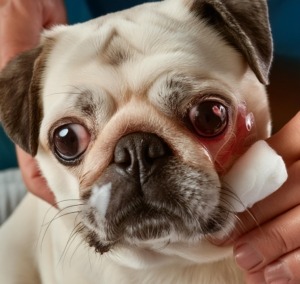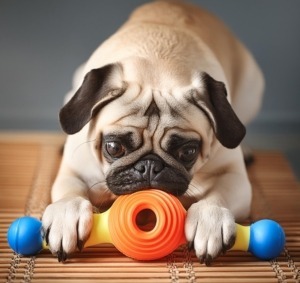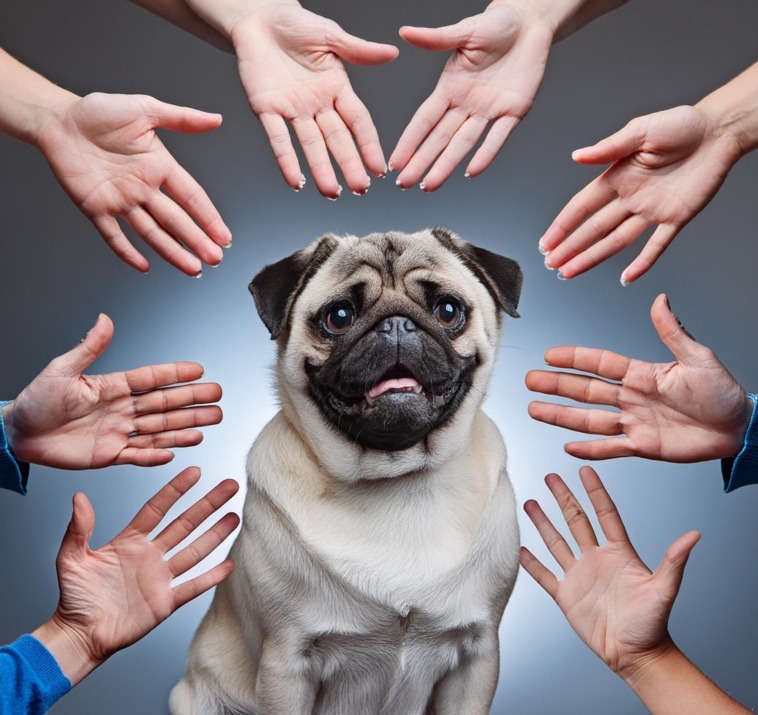Last updated on September 20th, 2024
Here’s an overview:
Introduction to Pug Care: Understanding Your Pet
Proper Nutrition for a Healthy Pug
Exercise & Physical Activity: Keeping Your Pug Fit
Grooming Essentials For A Happy Pug
Common Health Problems And Prevention
Training Your Pug: Behavioral Tips And Tricks
Mental Stimulation: How to Keep Your Pug Entertained
Regular Veterinary Check-ups and Vaccinations
Understanding and Responding to Your Pug’s Needs
Conclusion: Ensuring Happy Life for Your Pug Care
Introduction to Pug Care: Understanding Your Pet
The first thing you should know about taking care of your pugs is understanding what they need. Owning a pug is not easy; you need to be aware of their needs and wants because these dogs have unique characteristics. Some areas that require attention when it comes to caring for them are as follows:
- Diet: Feed high-quality, small breed dog food in order to maintain optimum body weight.
- Grooming: Brush their hair once per week and clean creases on faces lest bacteria cause infections which would lead to discomfort or even worse situations if ignored over time.
- Healthcare: Visit the vet regularly; check out breathing issues and eye problems among other things.
- Training: Utilize positive reinforcement methods especially during training sessions since pugs can be stubborn sometimes but this does not mean punishing them harshly every now then whenever you feel like it.
If these things are well understood then there won’t be any problem with keeping them healthy thus making both parties happy too!
Proper Nutrition for a Healthy Pug
Good nutrition plays a major role towards general well being of any living thing including pugs. A balanced diet should contain:
- High Quality Protein: Chicken fish or beef may also work just fine and do best pug care.
- Essential Fatty Acids (Omega 3 & 6): Helps promote healthy skin as well as good-looking fur coat; Carbohydrates such as whole grains e.g., brown rice or oats which provide energy required by the body throughout the day;
- Vitamins And Minerals Found In Fruits And Vegetables: These help boost immune system among other things too.

Feeding guidelines dictate that;
- Portion Control: Avoid obesity through accurate measurements while preparing meals for them;
- Consistent Feeding Schedule: Feed twice a day thus preventing hypoglycemia in pugs.
- Hydration needs to be ensured always therefore make sure fresh water is available at all times within reach of their location.
Exercise & Physical Activity: Keeping Your Pug Fit
A good exercise routine is essential for the wellbeing of any dog breed, pugs included.
- Walk them around the neighborhood for about 20-30 minutes twice every day;
- Use harness instead of collar during walks since it may cause strain on their necks hence making them uncomfortable or even leading to serious injuries if ignored over time.
Playtime
- Engage in interactive games with toys such as balls which they can chase around.
- Avoid activities that are too tiring since these dogs tend not to have much stamina compared to other breeds like Labradors etc.
Indoor Activities
- Puzzle Toys For Mental Stimulation: These are great when it comes to keeping your pet mentally active especially when you’re away from home working or running errands etc.
- Short Indoor Games Like Fetch: This game helps keep them entertained while indoors since there might not be enough space outside where fetching can take place easily due to limited areas available or safety concerns associated with certain environments etc.
Temperature Considerations
- During hot weather conditions try taking walks early morning hours before sunrise so that both of you don’t get exposed too much heat while outdoors which could lead overheating problems later on.
- On extremely cold days avoid going out unless necessary besides wearing appropriate warm clothing items for such occasions like jackets, boots etc.
Monitoring Weight
- Regular monitoring should be done i.e., weekly weigh-ins or whenever possible so that you keep track on whether they are gaining weight too fast or slow among other things too.
- Effective exercise planning ensures healthy & happy life for your four-legged friend.
Grooming Essentials For A Happy Pug
Grooming plays a significant role in maintaining the happiness and health of pugs. Regular brushing helps manage their shedding; ideally use a rubber grooming mitt or medium-bristle brush.
- Bathing: Bathe them once every 1-2 months using dog-specific hypoallergenic shampoo.
- Nail Care: Trim nails after every 3-4 weeks in order to prevent overgrowth; it is advisable to use nail grinders designed for dogs but clippers can also work just fine too!
- Ear Cleaning: Check ears weekly then clean using vet-recommended ear cleaner so as to avoid infections which might lead discomfort or even worse situations if left untreated overtime.
- Dental Hygiene: Brush their teeth several times a week using dog specific toothpaste and toothbrush.
- Wrinkle Care: Clean facial wrinkles daily with a damp cloth ensuring thorough drying afterwards.
Managing Your Pug’s Respiratory Health
Due to their brachycephalic nature, pugs are susceptible to respiratory problems. This is why it is important to be proactive when managing their respiratory health.
- Regular vet check-ups: Schedule routine veterinary visits so as to monitor the functioning of the respiratory system and detect any issues early enough.
- Maintain ideal weight: Extra pounds can make it harder for them to breathe thus worsening their condition. Feed them with a balanced diet and control portion sizes.
- Air quality: Use air purifiers that help reduce indoor allergens such as dust mites or pet dander. Also, do not smoke around the pug.
- Controlled exercise: Exercise is good for their overall well-being but during hot weather don’t overexert them since this might lead to breathing difficulty. Take short walks instead.
- Avoid stress: Stressful situations may cause labored breathing in dogs. Therefore, create a calm environment for your pet and employ calming techniques whenever necessary.
Common Health Problems And Prevention
Being genetically different from other breeds, pugs have some unique features which usually result into various health concerns if not taken pug care of in time. Here are the most common ones:
- Breathing difficulties: Brachycephalic Obstructive Airway Syndrome (BOAS) is a common problem among pugs which can cause severe breathing distresses. In order to minimize its effects; avoid strenuous activities, ensure they stay at their right weight and keep off excessive heat.
- Hip dysplasia: This is an abnormality affecting hip joints making movement painful or difficult sometimes leading even up into lameness if left untreated especially during old age stage where bones become weak . It’s therefore advisable that you feed them on balanced diets while providing low impact exercises like swimming may greatly help alleviate this issue altogether.
- Eye conditions: Pugs tend to develop corneal ulcers frequently due dryness eyes; hence one should always check for any signs of irritation around them then consult a vet immediately on what measures should be taken.

- Skin problems: In order to prevent infections in these areas, it’s important to keep the folds clean and dry all the time. You can as well bath them regularly while grooming their coats so that you are able to notice if there is anything wrong with it early enough before things get out of hand.
Training Your Pug: Behavioral Tips And Tricks
Pugs require patience and consistency during training sessions due their unique traits which may make things appear difficult at times hence understanding this breed better can greatly enhance success rate achieved through such exercises.
- Consistency: use same commands throughout entire process; it helps them know what exactly is expected from every given situation.
- Positive reinforcement: reward good behavior using treats or praise but never punish severely as this could lead into anxiety disorders later on since pugs are very sensitive emotionally speaking.
- Socialization: introduce your dog early enough when still young one different environments , people and pets so that they become well adapted socially thus making friends easily even among other animals like cats or rabbits etcetera besides humans alone.
- Crate training: teach them how crate works by slowly getting used staying inside until eventually becoming part sleeping area too besides serving transportation purposes only.
Mental Stimulation: How to Keep Your Pug Entertained
It is important for the overall health of a Pug that they are kept mentally stimulated. Owners can challenge their problem-solving skills by using interactive toys and puzzle feeders. Rotating toys regularly prevents boredom. Training sessions provide mental exercise as they teach new commands and tricks. Their attention span can be sustained with short, frequent play sessions.
Activities to Try:
- Interactive Toys: Toys that give treats when solved
- Puzzle Feeders: Slow down mealtime while engaging their mind
- Training Sessions: Short sessions focusing on new tricks
- Play Dates: Socialize with other dogs to stimulate them mentally

These pug care strategies will keep your pugs mind sharp and prevent behavioral issues caused by boredom.
Regular Veterinary Check-ups and Vaccinations
Frequent veterinary check-ups and vaccinations are very important in maintaining a healthy life for your pug. Yearly exams are useful in early detection of potential health issues. Vets assess vital signs, respiratory function, weight monitoring among others; common pug conditions such as hip dysplasia, eye problems or allergies may also be checked for during these visits.
Key Components:
- Vaccinations: Rabies, parvovirus, distemper etcetera should not be taken lightly
- Parasite Control: Fleas ticks worms routine checks necessary
- Dental Health: Regular cleaning needed to prevent dental disease
- Diet & Nutrition Advice: Balanced diet specific to pugs needs recommended by professional veterinarians
Regular regular checkups are necessary for a happy, healthy pug.
Understanding and Responding to Your Pug’s Needs
Understanding their requirements ensures they are well taken care of which in turn improves their quality of life.
- Diet & Nutrition: Balanced diet, prevent obesity by avoiding overfeeding.
- Exercise: Engagements should be moderate, avoid excessive exercise as this might lead to breathing difficulties since they are prone to respiratory problems
- Grooming: Brush coat regularly, it reduces shedding thus keeping them clean always.
- Health Monitoring: Regular checkups vital signs like hip dysplasia and eye problems may be checked out for frequently by a vet who will tell if there is any problem with these areas
- Social Interaction: Give them enough love so they can feel happy around other people but don’t forget that sometimes all we need is some time alone too!
Conclusion: Ensuring Happy Life for Your Pug Care
To ensure your pugs live long healthy lives there are certain things that one must do consistently over time. You should make sure you visit vets regularly as well as give them necessary vaccinations.
Exercise should be part of every day routine but it shouldn’t be too much because if it gets exhausted easily then its heart could stop beating altogether; dental care can also be provided through brushing its teeth twice weekly using dog toothpaste plus treats designed specifically for this purpose could be given too. Give love always and mental stimulation as well; groom it often so its skin remains healthy. Finally, be on high alert for signs of common health issues and get professional advice whenever this happens.




